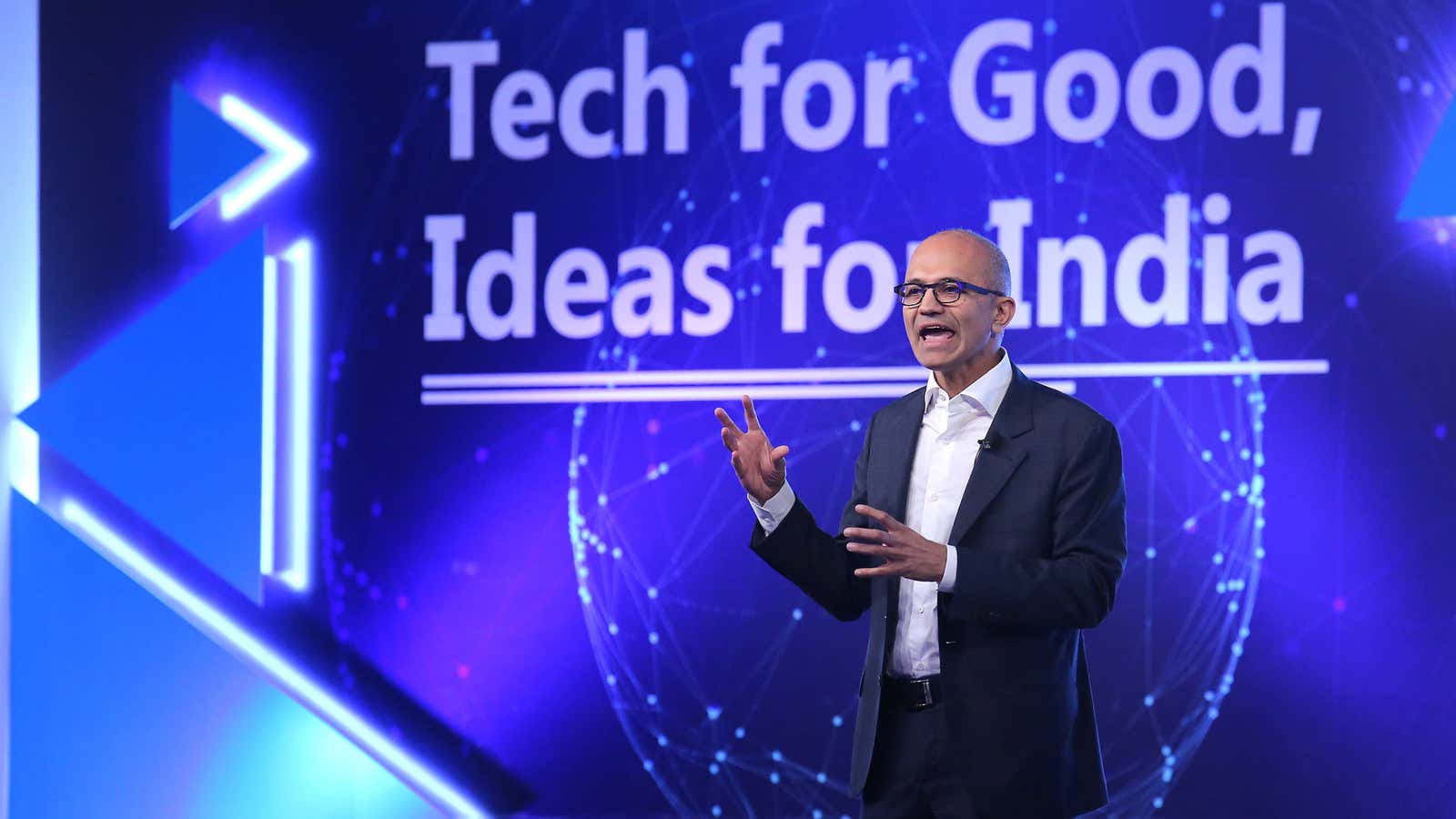The likes of Facebook and Google are tired of saturated, tech-savvy markets like Japan and the US. To find their next frontier for growth, they’re turning to India.
Their primary strategy to lure more people to their products is to bring more people online in the first place. Facebook’s Internet.org offering to give India free internet was eventually scrapped over net neutrality concerns but the tech giant came back with a plan B: Express Wi-Fi, a program that allows customers to purchase low-cost data packages to access fast internet via local hotspots. Google is on track to install free wifi at 400 railway stations across the country.
Now it’s Microsoft’s turn to woo Indian customers, and the company is targeting every rung of the commercial ecosystem: offering students more streamlined job search results, giving rural job-seekers the ability to look for opportunities even if they have low connectivity and even lower skill levels, and providing cloud services to thousands of startups, as well as the leading companies in the country.
In May 2016, when Apple chief executive Tim Cook made his first-ever visit to India, he was seen currying favor at temples, Bollywood parties, and cricket matches. After his trip, Apple secured permission to set up brick-and-mortar stores in the country and forged a partnership with Reliance Jio, an LTE mobile network operator in India, to offer a free first year of Jio’s “all-IP network…with 4G coverage in 18,000 cities and 200,000 villages across the country” for first-time iPhone buyers. In September, Apple teamed up with the Indian e-commerce site Flipkart to sell Apple products online.
At the start of his three-day maiden visit to India as Microsoft’s chief executive officer this week, Satya Nadella met with prime minister Narendra Modi and IT minister Ravi Shankar Prasad. Back in 2015, Microsoft began working with local governments to build 50 “smart” villages in the state of Maharashtra; the idea was to streamline the e-governance experience in everything from local policy to healthcare. In a meeting with Maharashtra chief minister Devendra Fadnavis this week, Nadella said he hopes to scale up the project further.
On Feb. 20, Nadella participated in a 30-minute fireside chat with Infosys co-founder and former CEO Nandan Nilekani, in which the Microsoft chief praised India’s thriving startup ecosystem. “The center of the entrepreneurial energy for us in India is all around the cloud,” Nadella said at the event, attended by nearly 1,000 techies and academics, including some of India’s most prolific entrepreneurs, like Flipkart’s Binny Bansal and InMobi’s Naveen Tewari.
Nadella claimed that more than 2,000 nascent Indian startups use Microsoft’s cloud services. In the last week, Microsoft also cracked a deal of its own with India’s largest domestic e-commerce player: Flipkart will now exclusively use Microsoft’s cloud.
Microsoft is also making a targeted bid for rural India. By introducing pared-down versions of its services, the company hopes to attract those who want to use the web but can’t afford to pay hefty data-usage prices. On Wednesday, Microsoft announced “lite” versions of Skype and LinkedIn.
Skype Lite uses only 13MB by compressing images and videos, so even 2G networks can use the app without disruptions. The app also integrates India’s biometric ID Aadhaar-based verification system.
Meanwhile, LinkedIn Lite, Microsoft says, will train people to become more skilled, leading to better employment opportunities for India’s less well-off.
Long before Nadella was helming Microsoft, the India-born engineer attended grade school in Hyderabad and went on to college at the Manipal Institute of Technology before immigrating to the US in the late 1980s. “The American values have always been about inclusion and diversity. It’s a land of immigrants. And I am a product of both,” Nadella said in a recent Q&A with the Economic Times.
Times have changed: These days, more and more Indians are electing to stay in the country after finishing school, and the government is making the effort to equip the country’s young adults with the technological and industrial knowledge necessary to propel its tech sector forward.
Microsoft is, apparently, also here to help. This week it announced a new product called “Project Sangam,” designed to bolster local talent creation and retention. India has the largest student population in the world but less than 10% of the country’s total population has graduated college, according to the most recent census data from 2011. And only 2% of the workforce is skilled.
Project Sangam is a LinkedIn-like platform to help semi-skilled workers and job-hunting college students find career placements. In addition, Project Sangam will offer cloud-based training courses so less-skilled workers can gain specific expertise.
The platform is currently in a testing phase and is awaiting public launch. It’ll be made available first to residents of the state of Andhra Pradesh.
